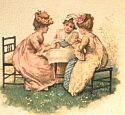 |
The
History Of "High Tea"
Prior
to the introduction of tea into Britain, the English had two
main meals, breakfast and dinner. Breakfast was ale, bread, and
beef. During the middle of the eighteenth century, dinner
for the upper and middle classes had shifted from noontime to
an evening meal that was served at a fashionable late hour. Dinner
was a long, massive meal at the end of the day.
Anna, the Duchess of Bedford
(1788-1861) is credited as the creator of teatime. Because the noon
meal had become skimpier, the Duchess suffered from "a sinking feeling" at
about four o'clock in the afternoon. At first the Duchess had her
servants sneak her a pot of tea and a few breadstuffs. Adopting the
European tea service format, she invited friends to join her for
an additional afternoon meal at five o'clock in her rooms at Belvoir
Castle. The menu centered around small cakes, bread and butter sandwiches,
assorted sweets, and, of course, tea. This summer practice proved
so popular, the Duchess continued it when she returned to London,
sending cards to her friends asking them to join her for "tea and
a walking the fields." The practice of inviting friends to come for
tea in the afternoon was quickly picked up by other social hostesses.
During the second
half of the Victorian Period, known as the Industrial Revolution,
working families would return home tired and exhausted. The
table would be set with any manner of meats, bread, butter,
pickles, cheese and of course tea. None of the dainty finger
sandwiches, scones and pastries of afternoon tea would have
been on the menu. Because it was eaten at a high, dining
table rather than the low tea tables, it was termed "high" tea.
|




